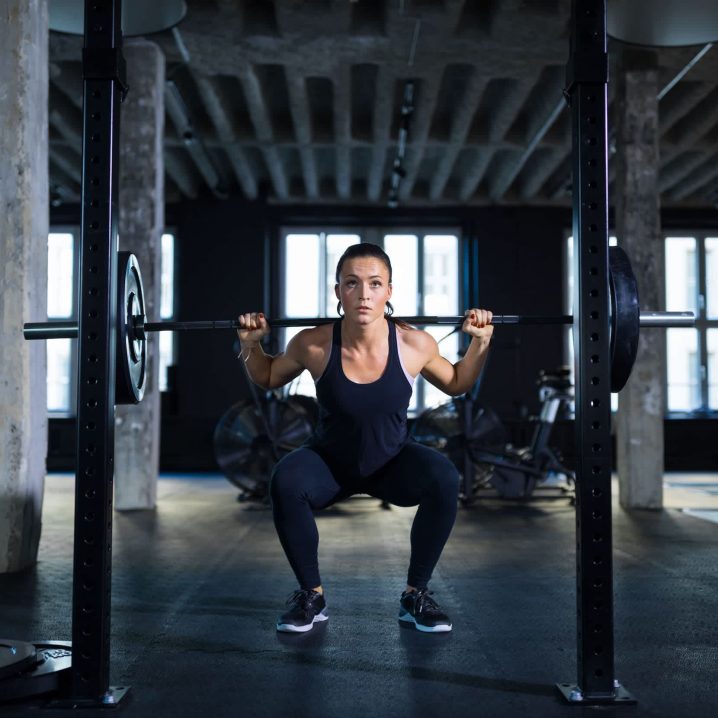
- POPSUGAR Australia
- Fitness
- 3 Squat Rack Mistakes That Could Lead to Painful Injuries
3 Squat Rack Mistakes That Could Lead to Painful Injuries

What’s worse than waiting a full 45 minutes for a spot at the ever-popular squat rack? Claiming your space and then promptly messing up on form and hobbling off with an injury.
The squat rack is a great tool for strengthening your lower body (hence why it’s always so busy), but like any machine at the gym, when not used properly, it can contribute towards serious pain.
To keep your squat session free of mishaps, we reached out to Kristopher Brathwaite, an ACE-certified personal trainer at New York Health and Racquet Club, who filled us in on the three common mistakes made while squatting.
Excessive Knee Valgus
Brathwaite says this term indicates your knees are collapsing inwards toward the midline of the body.
“An issue like this can cause injuries to the structures responsible for creating knee stability – MCL and ACL tears are what immediately come to mind, especially for athletes,” Brathwaite says.
“How we train the body is how the body will perform when it comes to more dynamic movements/activities that require stopping on a dime and changing directions.”
Related: Improve Your Running With Squats
Squatting Too Low
Stay away from “a** to the grass” squats. In other words, Brathwaite says this is when the squatter lowers their hips/butt below the knees – a movement that could lead to back strains or herniated discs.
Instead, Brathwaite suggests reaching a 90-degree angle in the squat. “A proper 90-degree angle between shoulder, hip, and knee joint will achieve the same result with less stress on the joints,” he adds.
Ignoring the Safety Arms
Brathwaite says that most commercial gyms and private training studios have a multipurpose rack that’s used for squats – and these squat racks typically have two long arms on both sides of the rack.
“These arms were designed to help you safely release the weight at the bottom of squats when you’re fatigued or [when] the weight is too heavy to propel yourself back to an upright position,” he explains.
“Oftentimes, I see beginner to intermediate squatters not utilizing them and dropping the weight off their back, falling backwards with the weight.”
This, in turn, he says could cause many different physical issues. In short, use the safety bars, or consult a certified personal trainer for best practices.
Related: If You Want to Work Your Legs and Butt More in Squats, Do This One Wall Exercise
There’s a few other things you can do to make sure your time at the squat rack is successful.
For starters, warm up!
“I suggest performing hip-opener stretches, core bracing techniques, body weight squats, and then going into a weighted warmup set,” Brathwaite says.
“This will ensure that you can reach an optimal range of motion without feeling tightness, reduce compensating through the utilization of other muscle groups, and more importantly, ‘waking up’ those muscle groups we’re about to use.”
You might also want to consider performing your squats toward the beginning of your workout.
“The reason being is because of the complexity of the squat and the necessity of all muscle groups working at their best to execute the movement properly,” he explains.
So, to prevent injury, Brathwaite suggests completing this exercise when you’re not tired and when your energy levels are high from having a meal 45 minutes to one hour before.
Related: These Are the 7 Exercises You Should Do If You Want a Bigger Butt, According to a Trainer
If you’re looking to master form, technique, or doing anything over 70 percent of your one-repetition maximum, Brathwaite suggests using a potter or performing a different squat variation to assist you in the movement – like Smith Machine squats, dumbbell goblet squats, or barbell box squats.
Finally, work with a certified personal trainer to build your personal exercise program based on your goals and reduce the chances of injury.
“Ask the practitioner to perform an example of what they want you to do if necessary,” Brathwaite says.
“This will help you to feel more comfortable performing them on your own while also knowing what to look for to make sure you’re completing them correctly. Solely working with someone – a friend for example – who’s used it before doesn’t guarantee you’ll be fed the right information that’s best for you considering each body, limb length, structure, and muscle imbalances are different. One size doesn’t fit all!”
Click here for more health and wellness stories, tips, and news.

